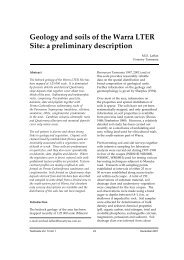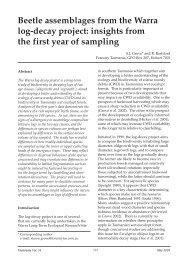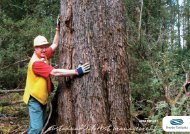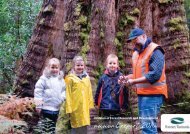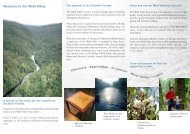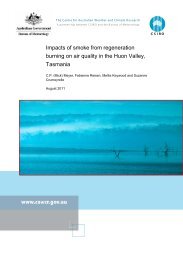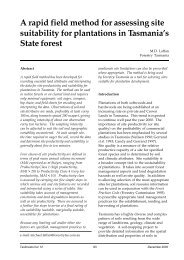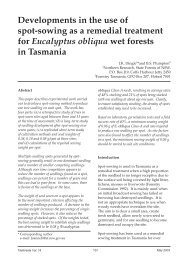The natural distribution of Eucalyptus species in Tasmania - Forestry ...
The natural distribution of Eucalyptus species in Tasmania - Forestry ...
The natural distribution of Eucalyptus species in Tasmania - Forestry ...
You also want an ePaper? Increase the reach of your titles
YUMPU automatically turns print PDFs into web optimized ePapers that Google loves.
<strong>Eucalyptus</strong> brookeriana<br />
SUBGENUS: Symphyomyrtus<br />
SERIES: Ovatae<br />
Common name:<br />
Brooker's gum<br />
Figure 12. Distribution <strong>of</strong><br />
E. brookeriana <strong>in</strong> <strong>Tasmania</strong>.<br />
Inset map: Distribution<br />
on ma<strong>in</strong>land Australia.<br />
<strong>Eucalyptus</strong> brookeriana has a broad geographic<br />
range and occurs locally <strong>in</strong> the warm, wet<br />
regions <strong>of</strong> the north-west, K<strong>in</strong>g Island and the<br />
east coast (Figure 12). It is usually located on<br />
well-dra<strong>in</strong>ed, rocky soils <strong>of</strong> dolerite slopes<br />
and ridges, on alluvial deposits adjacent to<br />
streams, or on the marg<strong>in</strong>s <strong>of</strong> blackwoodswamp<br />
forest. Small, scattered, isolated<br />
populations exist between the two large,<br />
disjunct centres <strong>in</strong> eastern and western<br />
<strong>Tasmania</strong>. Many additional occurrences <strong>in</strong><br />
pockets <strong>of</strong> suitable habitat between these<br />
population centres may be discovered.<br />
<strong>Eucalyptus</strong> brookeriana (Photos 4, 5) is the most<br />
recently described <strong>Tasmania</strong>n <strong>species</strong> (Gray<br />
1979), and previous occurrences were classified<br />
as E. ovata. Jackson (1965) dist<strong>in</strong>guished a<br />
western variant <strong>of</strong> E. ovata which may <strong>in</strong>clude<br />
forms currently classified as E. brookeriana.<br />
However, forms with aff<strong>in</strong>ities to E. ovata are<br />
also likely to occur <strong>in</strong> these western regions<br />
and E. brookeriana appears to <strong>in</strong>tergrade with<br />
E. ovata across its range, further confus<strong>in</strong>g<br />
the dist<strong>in</strong>ction between these two <strong>species</strong>.<br />
<strong>The</strong> two taxa are not well differentiated on<br />
reproductive traits, but the adult and juvenile<br />
Tasforests Vol. 8 55<br />
December 1996




